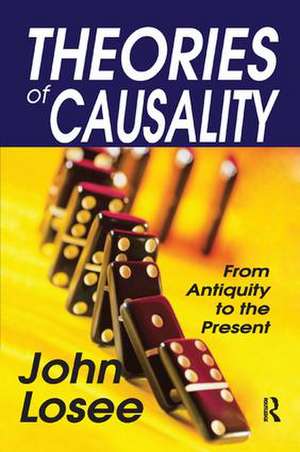Theories of Causality: From Antiquity to the Present
Editat de John Loseeen Limba Engleză Paperback – 28 sep 2017
Losee presents a number of theories of causality within a historical survey that emphasizes the interrelationship between these theories and developments in science. His analysis displays the strengths and weaknesses of these theories so as to contribute to our present understanding of causal relatedness.
Among the positions discussed are those of Aristotle, Hume, Kant, Mill, Salmon, Lewis, and Woodward. Losee's analysis displays the strengths and weaknesses of theories that identify causal relatedness with regularity of sequence, probability increase, energy transfer, exchange of a conserved quantity, counterfactual dependence, and inferability.These theories are judged, in part,by their ability to resolvedifficulties posed by instances of overdetermination,causation by omission, preventive causation, and causation by disconnection. Since applications of the theories to these instances disagree, a strategy of employing multiple concepts of causation is examined.
Theories of Causality also describes the particular difficulties for causal analysis posed by quantum mechanics. One such difficulty is the prohibition against combining a causal analysis of a quantum process with a spatio-temporal description of that process.
Preț: 324.16 lei
Preț vechi: 432.00 lei
-25% Nou
Puncte Express: 486
Preț estimativ în valută:
62.05€ • 67.42$ • 52.15£
62.05€ • 67.42$ • 52.15£
Carte tipărită la comandă
Livrare economică 21 aprilie-05 mai
Preluare comenzi: 021 569.72.76
Specificații
ISBN-13: 9781138517257
ISBN-10: 1138517259
Pagini: 218
Dimensiuni: 152 x 229 x 21 mm
Greutate: 0.45 kg
Ediția:1
Editura: Taylor & Francis
Colecția Routledge
Locul publicării:Oxford, United Kingdom
ISBN-10: 1138517259
Pagini: 218
Dimensiuni: 152 x 229 x 21 mm
Greutate: 0.45 kg
Ediția:1
Editura: Taylor & Francis
Colecția Routledge
Locul publicării:Oxford, United Kingdom
Cuprins
I: Classical Sources: Theories of Causality Prior to 1900; 1: Aristotle on the Four Aspects of Causation; 2: Medieval Science and the Discovery of Causes; 3: Francis Bacon on the Exclusion of Final Causes; 4: The Revival of Atomism; 5: Causes, Impacts, and Action-at-a-Distance; 6: David Hume on Causality; 7: Kant’s Response to Hume’s Regularity View; 8: J. S. Mill on Invariable and Unconditional Correlations; 9: Options for a Theory of Causality ca. 1900; II: Early Twentieth-Century Theories: Dominance of the Regularity View; 10: C. S. Peirce on Causation and Causality; 11: Karl Pearson’s Version of the Regularity View; 12: ; 13: Causality in Physics: Revision of the Regularity View; III: Quantum Mechanics and the Regularity-between-States View; 14: The Interpretation of Quantum Phenomena; 15: Causality and the Three Levels of Language in Quantum Mechanics; 16: Philipp Frank on Causality and Inferability; IV: Protests against the Identification of Causality and Regularity; 17: Ducasse and the Singularity Definition; 18: Cause as Sufficient Condition; 19: Probabilistic Causality; 20: Wesley Salmon on Processes and Interactions; 21: Phil Dowe and the Conserved Quantity Theory; 22: Causality and the Transfer of Energy or Momentum; 23: Causality and Powers; 24: Manipulability and Causality; 25: David Lewis and the Counterfactual Conditional View; 26: Criteria of Causal Status; 27: Multiple Concepts of Causality; 28: Conflicting Criteria of Causal Status
Descriere
What types of entities qualify as causes and effects? What is the relationship between cause and effect? How are causal claims to be assessed? The first question deals with the structure of the world; the second about theories that interpret the relationship of causes to effects; the third to do with proper procedure in science and everyday life
